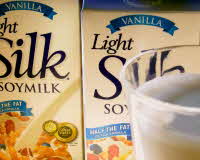SOY BEANS AND SOY PRODUCTSEarthTalk (May 5, 2011) Dear Earth Talk: How healthy is soy? I heard that, despite its healthy image, most soy is grown using chemicals like other crops and is even being genetically modified.
-- D. Frinka, Syracuse, NY
Food products made with soy have enjoyed great popularity in the U.S. and elsewhere in recent years. Two decades ago, Americans spent $300 million a year on soy food products; today we spend over $4 billion. More and more adults are substituting soy—a great source of protein—for meat, while a quarter of all baby formula contains soy instead of milk. Many school lunch programs nationwide have added soy-based veggie burgers to their menus, as have countless restaurants, including diners and fast food chains.
And there are hundreds of other edible uses of the legume, which now vies with corn for the title of America's most popular agricultural crop. The U.S. Food and Drug Administration promotes the inclusion of soy into other foods to cut down on heart attack risk. Clinical studies have shown that soy can also lower the risk for certain types of breast and prostate cancer.

Americans today spend upwards of $4 billion yearly on soy food products. Although the versatile soybean provides many health benefits, some 90 percent of the U.S. crop is grown using genetically modified seeds, engineered to withstand repeated dousing with Monsanto's herbicide, glyphosate (popularly known as RoundUp).
Photo: Timothy Valentine, courtesy Flickr.
|
|
But there may be a dark side to soy’s popularity and abundance. “Many of soy’s health benefits have been linked to isoflavones—plant compounds that mimic estrogen,” reports Lindsey Konkel in Environmental Health News. “But animal studies suggest that eating large amounts of those estrogenic compounds might reduce fertility in women, trigger premature puberty and disrupt development of fetuses and children.” But before you dump out all your soy foods, note that the operative phrase here is “large amounts” which, in laboratory science, can mean amounts substantially above what one would consume in real life.
Also at issue is that upwards of 90 percent of the U.S. soybean crop is grown using genetically modified (GM) seeds sold by Monsanto. These have been engineered to withstand repeated dousing with the herbicide, glyphosate (also sold by Monsanto and marketed as RoundUp). According to the nonprofit Non GMO Project, this allows soybean farmers to repeatedly spray their fields with RoundUp to kill all weeds (and other nearby plant life) except for the soybean plants they are growing.
The U.S. government permits the sale and consumption of GM foods, but many consumers aren’t so sure it’s OK to eat them—given not only the genetic tinkering but also the exposure to so much glyphosate. Due to these concerns, the European Union has had a moratorium on GM crops of all kinds since 1998.
The fact that genetically modified soy may be present in as much as 70 percent of all food products found in U.S. supermarkets means that a vast majority of Americans may be putting a lot of GM soy into their systems every day. And not just directly via cereals, breads and pasta: Some 98 percent of the U.S. soybean crop is fed to livestock, so consumers of meat, eggs and dairy are indirectly ingesting the products of scientific tinkering with unknown implications for human health.
Since GM soy has only been around and abundant for less than a decade, no one yet knows for sure what the long term health effects, if any, will be on the populations of countries such as the U.S. that swear by it. Natural foods stores like WholeFoods are your best bet for finding non-GM foods of all sorts.
CONTACTS: Environmental Health News, www.ehn.org/ ; Non GMO Project, www.nongmoproject.org
EarthTalk® is written and edited by Roddy Scheer and Doug Moss and is a registered trademark of E - The Environmental Magazine (www.emagazine.com). Send questions to: earthtalk@emagazine.com
| 